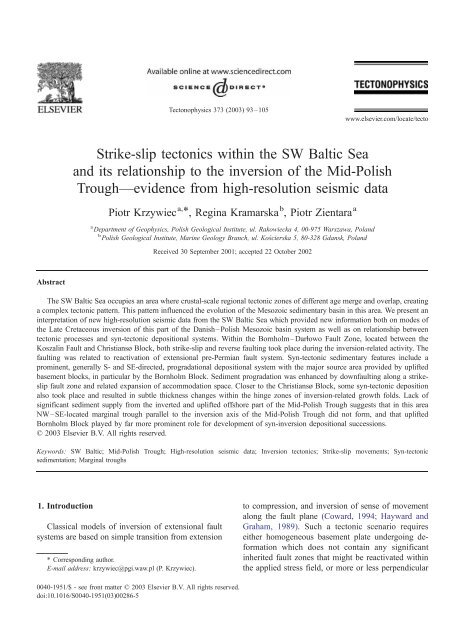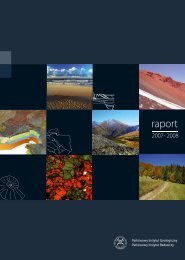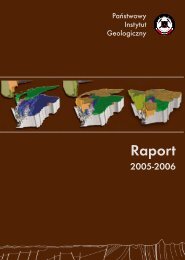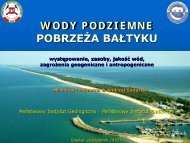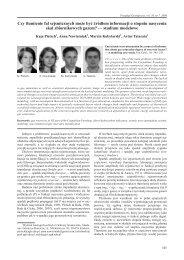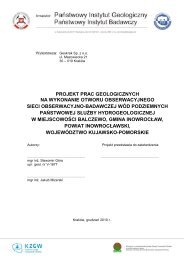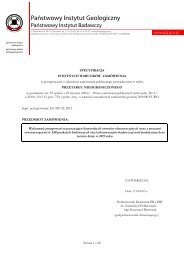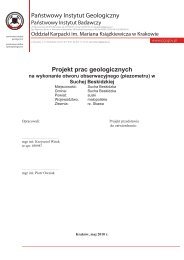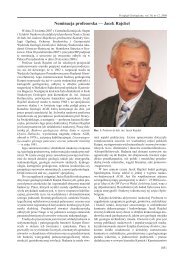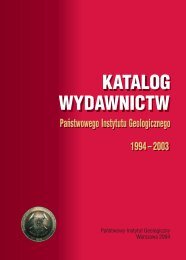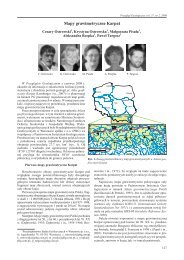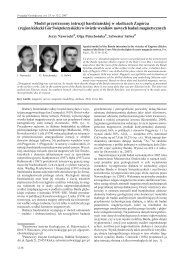Strike-slip tectonics within the SW Baltic Sea and its relationship to ...
Strike-slip tectonics within the SW Baltic Sea and its relationship to ...
Strike-slip tectonics within the SW Baltic Sea and its relationship to ...
Create successful ePaper yourself
Turn your PDF publications into a flip-book with our unique Google optimized e-Paper software.
Abstract<br />
<strong>Strike</strong>-<strong>slip</strong> <strong>tec<strong>to</strong>nics</strong> <strong>within</strong> <strong>the</strong> <strong>SW</strong> <strong>Baltic</strong> <strong>Sea</strong><br />
<strong>and</strong> <strong>its</strong> <strong>relationship</strong> <strong>to</strong> <strong>the</strong> inversion of <strong>the</strong> Mid-Polish<br />
Trough—evidence from high-resolution seismic data<br />
Piotr Krzywiec a, *, Regina Kramarska b , Piotr Zientara a<br />
a Department of Geophysics, Polish Geological Institute, ul. Rakowiecka 4, 00-975 Warszawa, Pol<strong>and</strong><br />
b Polish Geological Institute, Marine Geology Branch, ul. Kos´cierska 5, 80-328 Gdansk, Pol<strong>and</strong><br />
Received 30 September 2001; accepted 22 Oc<strong>to</strong>ber 2002<br />
The <strong>SW</strong> <strong>Baltic</strong> <strong>Sea</strong> occupies an area where crustal-scale regional tec<strong>to</strong>nic zones of different age merge <strong>and</strong> overlap, creating<br />
a complex tec<strong>to</strong>nic pattern. This pattern influenced <strong>the</strong> evolution of <strong>the</strong> Mesozoic sedimentary basin in this area. We present an<br />
interpretation of new high-resolution seismic data from <strong>the</strong> <strong>SW</strong> <strong>Baltic</strong> <strong>Sea</strong> which provided new information both on modes of<br />
<strong>the</strong> Late Cretaceous inversion of this part of <strong>the</strong> Danish–Polish Mesozoic basin system as well as on <strong>relationship</strong> between<br />
tec<strong>to</strong>nic processes <strong>and</strong> syn-tec<strong>to</strong>nic depositional systems. Within <strong>the</strong> Bornholm–Darlowo Fault Zone, located between <strong>the</strong><br />
Koszalin Fault <strong>and</strong> Christiansø Block, both strike-<strong>slip</strong> <strong>and</strong> reverse faulting <strong>to</strong>ok place during <strong>the</strong> inversion-related activity. The<br />
faulting was related <strong>to</strong> reactivation of extensional pre-Permian fault system. Syn-tec<strong>to</strong>nic sedimentary features include a<br />
prominent, generally S- <strong>and</strong> SE-directed, progradational depositional system with <strong>the</strong> major source area provided by uplifted<br />
basement blocks, in particular by <strong>the</strong> Bornholm Block. Sediment progradation was enhanced by downfaulting along a strike<strong>slip</strong><br />
fault zone <strong>and</strong> related expansion of accommodation space. Closer <strong>to</strong> <strong>the</strong> Christiansø Block, some syn-tec<strong>to</strong>nic deposition<br />
also <strong>to</strong>ok place <strong>and</strong> resulted in subtle thickness changes <strong>within</strong> <strong>the</strong> hinge zones of inversion-related growth folds. Lack of<br />
significant sediment supply from <strong>the</strong> inverted <strong>and</strong> uplifted offshore part of <strong>the</strong> Mid-Polish Trough suggests that in this area<br />
NW–SE-located marginal trough parallel <strong>to</strong> <strong>the</strong> inversion axis of <strong>the</strong> Mid-Polish Trough did not form, <strong>and</strong> that uplifted<br />
Bornholm Block played by far more prominent role for development of syn-inversion depositional successions.<br />
D 2003 Elsevier B.V. All rights reserved.<br />
Keywords: <strong>SW</strong> <strong>Baltic</strong>; Mid-Polish Trough; High-resolution seismic data; Inversion <strong>tec<strong>to</strong>nics</strong>; <strong>Strike</strong>-<strong>slip</strong> movements; Syn-tec<strong>to</strong>nic<br />
sedimentation; Marginal troughs<br />
1. Introduction<br />
Classical models of inversion of extensional fault<br />
systems are based on simple transition from extension<br />
* Corresponding author.<br />
E-mail address: krzywiec@pgi.waw.pl (P. Krzywiec).<br />
Tec<strong>to</strong>nophysics 373 (2003) 93–105<br />
0040-1951/$ - see front matter D 2003 Elsevier B.V. All rights reserved.<br />
doi:10.1016/S0040-1951(03)00286-5<br />
www.elsevier.com/locate/tec<strong>to</strong><br />
<strong>to</strong> compression, <strong>and</strong> inversion of sense of movement<br />
along <strong>the</strong> fault plane (Coward, 1994; Hayward <strong>and</strong><br />
Graham, 1989). Such a tec<strong>to</strong>nic scenario requires<br />
ei<strong>the</strong>r homogeneous basement plate undergoing deformation<br />
which does not contain any significant<br />
inherited fault zones that might be reactivated <strong>within</strong><br />
<strong>the</strong> applied stress field, or more or less perpendicular
94<br />
orientation of inherited fault zones <strong>to</strong> <strong>the</strong> extensional<br />
<strong>and</strong> compressional stress fields. Regional obliquity of<br />
inherited basement faults <strong>and</strong> <strong>the</strong> stress field often<br />
results in formation of transverse fault zones during<br />
rifting <strong>and</strong> subsequent basin development (Cartwright,<br />
1987), as well as strike-<strong>slip</strong> movements <strong>and</strong> development<br />
of positive flower structures during inversion<br />
(Harding, 1985; Woodcock <strong>and</strong> Schubert, 1994;<br />
Lihou <strong>and</strong> Allen, 1996). Within hinge zones of<br />
inversion-related folds, thickness reductions of syninversion<br />
depos<strong>its</strong> accompanied by localised progradational<br />
pattern are often observed <strong>and</strong> indicate syndepositional<br />
tec<strong>to</strong>nic activity (Cartwright, 1989).<br />
High-resolution seismics is a very powerful research<br />
<strong>to</strong>ol in studies of <strong>the</strong> Cenozoic evolution of<br />
<strong>the</strong> offshore areas, as is shown, e.g. by recent studies<br />
of Cenozoic his<strong>to</strong>ry of <strong>the</strong> Danish North <strong>Sea</strong>. In this<br />
area, shallow seismic profiles imaged both detailed<br />
depositional architecture of Cenozoic depos<strong>its</strong><br />
(Michelsen et al., 1998; Clausen et al., 1999), often<br />
deformed by tec<strong>to</strong>nic (e.g. glacitec<strong>to</strong>nic) <strong>and</strong> erosional<br />
processes (Huuse <strong>and</strong> Lykke-Andersen,<br />
2000a,b), as well as <strong>the</strong>ir immediate substratum<br />
(Huuse, 1999). Regional coverage of shallow seismic<br />
data combined with well information <strong>and</strong> petroleum<br />
seismic data provided a database allowing for construction<br />
of a regional model of Cenozoic evolution<br />
of this large offshore area (Clausen <strong>and</strong> Huuse, 1999;<br />
Huuse et al., 2001).<br />
New offshore high-resolution seismic data from <strong>the</strong><br />
sou<strong>the</strong>rn <strong>Baltic</strong> <strong>Sea</strong> are presented here. This data set<br />
documents modes of <strong>the</strong> Late Cretaceous inversion<br />
<strong>tec<strong>to</strong>nics</strong> <strong>within</strong> <strong>the</strong> wide zone stretching between <strong>the</strong><br />
isl<strong>and</strong> of Borholm <strong>and</strong> <strong>the</strong> Polish coast, in particular<br />
large amount of strike-<strong>slip</strong> deformations related <strong>to</strong> <strong>the</strong><br />
inversion. The interpretation has led <strong>to</strong> an updated <strong>and</strong><br />
refined tec<strong>to</strong>nic map of <strong>the</strong> <strong>SW</strong> <strong>Baltic</strong> <strong>Sea</strong>.<br />
2. Geological setting<br />
The <strong>SW</strong> <strong>Baltic</strong> <strong>Sea</strong> forms part of a very complicated<br />
area where several important regional tec<strong>to</strong>nic zones<br />
<strong>and</strong> lines overlap <strong>and</strong> merge, including Sorgenfrei–<br />
Tornquist Zone (STZ), Teisseyre–Tornquist Zone<br />
(TTZ) <strong>and</strong> <strong>the</strong> Caledonian deformation front (Fig. 1;<br />
Pharaoh, 1999 <strong>and</strong> references <strong>the</strong>rein). Research projects<br />
including deep seismic reflection profiling have<br />
P. Krzywiec et al. / Tec<strong>to</strong>nophysics 373 (2003) 93–105<br />
Fig. 1. Location of <strong>the</strong> study area (rectangle) <strong>and</strong> <strong>its</strong> <strong>relationship</strong> <strong>to</strong><br />
<strong>the</strong> major crustal features of <strong>the</strong> North Europe, including <strong>the</strong><br />
Precambrian East European Platform, <strong>the</strong> Palaeozoic West European<br />
Platform, <strong>the</strong> Caledonian, Variscan <strong>and</strong> Carpathian orogenic fronts,<br />
<strong>the</strong> Tornquist–Teisseyre Zone (TTZ) <strong>and</strong> <strong>the</strong> Sorgenfrei–Tornquist<br />
Zone (STZ) (after Pharaoh, 1999, simplified <strong>and</strong> modified).<br />
been completed in this area (EUGENO-S Working<br />
Group, 1988; BABEL Working Group, 1991; Meissner<br />
et al., 1994), <strong>and</strong> numerous alternative hypo<strong>the</strong>ses<br />
have been formulated on various aspects of <strong>its</strong> presentday<br />
crustal structure <strong>and</strong> geodynamic evolution (e.g.<br />
Pegrum, 1984; Tanner <strong>and</strong> Meissner, 1996; Ber<strong>the</strong>lsen,<br />
1998). However, even <strong>the</strong> basic features that<br />
characterise <strong>SW</strong> <strong>Baltic</strong> <strong>Sea</strong> <strong>and</strong> surrounding areas such<br />
as <strong>the</strong> extent of <strong>Baltic</strong>a <strong>and</strong> Avalonia blocks, existence<br />
of <strong>the</strong> Trans-European Fault, <strong>and</strong> <strong>the</strong> presence <strong>and</strong><br />
exact location of Caledonian deformation front are still<br />
discussed <strong>and</strong> no consensus has been reached yet<br />
(Thybo, 1997, 2001; Franke, 1990; Dadlez, 2000;<br />
Lassen et al., 2001; McCann <strong>and</strong> Krawczyk, 2001).<br />
During Permian through Cretaceous times several<br />
sedimentary basins <strong>and</strong> sub-basins of <strong>the</strong> so-called<br />
Peri-Tethys domain developed in Western <strong>and</strong> Central<br />
Europe due <strong>to</strong> post-orogenic destruction of <strong>the</strong> Variscan<br />
forel<strong>and</strong> initiated by Late Carboniferous wrenching<br />
<strong>and</strong> strike-<strong>slip</strong> movements (Brochwicz-Lewiński<br />
et al., 1984; Ziegler, 1990; van Wees et al., 2000).<br />
Significant subsidence <strong>and</strong> deposition <strong>to</strong>ok place<br />
along <strong>the</strong> Sorgenfrei–Tornquist Zone in Scania <strong>and</strong>
Kattegat (Norling <strong>and</strong> Bergstrom, 1987; Mogensen<br />
<strong>and</strong> Jensen, 1994; Michelsen, 1997) <strong>and</strong> <strong>the</strong> Teisseyre–Tornquist<br />
Zone (TTZ) in Pol<strong>and</strong>. Along <strong>the</strong><br />
TTZ, <strong>the</strong> Polish Basin developed with <strong>its</strong> mostly<br />
subsided axial part, Mid-Polish Trough (MPT; Poz˙aryski<br />
<strong>and</strong> Brochwicz-Lewiński, 1978; Dadlez et al.,<br />
1995; van Wees et al., 2000). During Late Cretaceous–Cenozoic<br />
inversion of <strong>the</strong> Peri-Tethyan epicontinental<br />
sedimentary basins, various faults <strong>and</strong><br />
fault zones have been reactivated <strong>and</strong> gave rise <strong>to</strong><br />
<strong>the</strong> development of <strong>the</strong> inversion structures (e.g.<br />
Ziegler, 1989; Ziegler et al., 1995; Roure <strong>and</strong> Colletta,<br />
1996). In a regional sense, spreading <strong>within</strong> <strong>the</strong><br />
Atlantic domain, <strong>and</strong> Alpine–Carpathian collision<br />
have generated compressional stresses that were transferred<br />
in<strong>to</strong> <strong>the</strong> forel<strong>and</strong> plate <strong>and</strong> resulted in reactivation<br />
<strong>and</strong> inversion of faults responsible for <strong>the</strong><br />
formation of Mesozoic sedimentary basins. During<br />
inversion of Peri-Tethyan domain also <strong>the</strong> sedimentary<br />
basins developed along <strong>the</strong> STZ <strong>and</strong> TTZ underwent<br />
inversion (e.g. Poz˙aryski <strong>and</strong> Brochwicz-Lewiński,<br />
1978; Vejbæk <strong>and</strong> Andersen, 1987; Mogensen <strong>and</strong><br />
Jensen, 1994; Dadlez, 1997; Dronkers <strong>and</strong> Mrozek,<br />
1991; Krzywiec, 2000, 2002a).<br />
A complicated regional stress field generated by<br />
<strong>the</strong> Atlantic spreading <strong>and</strong> <strong>the</strong> Alpine–Carpathian<br />
collision superimposed on equally complicated regional<br />
fault pattern related <strong>to</strong> both pre-Permian (Variscan<br />
<strong>and</strong> Caledonian) tec<strong>to</strong>nic events <strong>and</strong> Permian–<br />
Mesozoic basin development, resulted in various<br />
modes <strong>and</strong> amounts of inversion. During <strong>the</strong> Late<br />
Cretaceous inversion of <strong>the</strong> MPT, including <strong>its</strong> offshore<br />
part located in <strong>the</strong> <strong>SW</strong> <strong>Baltic</strong> <strong>Sea</strong>, various<br />
inversion-related structures developed like reverse<br />
faults <strong>and</strong> associated fault-propagation folds, <strong>and</strong><br />
NW–SE- or SE–NW-oriented flower structures induced<br />
by strike-<strong>slip</strong> movements (Poz˙aryski, 1977;<br />
An<strong>to</strong>nowicz et al., 1994; Strzetelski et al., 1995;<br />
Schlüter et al., 1997; Krzywiec, 2000, 2002a).<br />
The onshore NW part of <strong>the</strong> MPT, located in<br />
immediate vicinity of <strong>the</strong> study area, is built of several<br />
crustal blocks related <strong>to</strong> Palaeozoic <strong>and</strong> Precambrian<br />
platforms (Znosko, 1979; Guterch et al., 1994;<br />
Dadlez, 1997, 2000; Petecki, 2001; Królikowski <strong>and</strong><br />
Petecki, 1997). The MPT can be traced <strong>to</strong>wards <strong>the</strong><br />
area <strong>SW</strong> of Bornholm (Fig. 2). In this region, <strong>the</strong><br />
NW–SE trending Kamien Pomorski–Adler <strong>and</strong> Koszalin<br />
faults form NE <strong>and</strong> <strong>SW</strong> borders of <strong>the</strong> inverted<br />
P. Krzywiec et al. / Tec<strong>to</strong>nophysics 373 (2003) 93–105 95<br />
Fig. 2. Tec<strong>to</strong>nic map of <strong>the</strong> Bornholm–Darlowo Fault Zone<br />
(according <strong>to</strong> Kramarska et al., 1999, modified <strong>and</strong> supplemented<br />
using results of Deeks <strong>and</strong> Thomas, 1995; Vejbæk,<br />
1985; Vejbæk et al., 1994, <strong>and</strong> unpublished Petrobaltic maps).<br />
Thin lines—shallow high-resolution seismic lines, thick lines<br />
with numbers—location of seismic examples with appropriate<br />
figure numbers.<br />
MPT, respectively (Fig. 2; Dadlez <strong>and</strong> Mlynarski,<br />
1967; Dadlez, 1974, 1976; Poz˙aryski et al., 1978;<br />
Liboriussen et al., 1987; Poz˙aryski <strong>and</strong> Witkowski,<br />
1990; Thomas et al., 1993; Dadlez et al., 1995;<br />
Kramarska et al., 1999). These two fault zones form<br />
an extensional (possibly partly transtensional) fault<br />
system inverted in a compressional (possibly partly<br />
transpressional) tec<strong>to</strong>nic regime. Asymmetric faultpropagation<br />
folds developed <strong>within</strong> <strong>the</strong> Mesozoic<br />
basin infill above major inversion-related reverse<br />
faults <strong>within</strong> <strong>the</strong> pre-Zechstein basement (Schlüter et<br />
al., 1997; Krzywiec, 2000, 2002a; Dadlez, 2001). Itis<br />
not possible <strong>to</strong> precisely determine <strong>the</strong> onset of<br />
inversion in this part of <strong>the</strong> MPT due <strong>to</strong> significant<br />
uplift of inversion anticlines, related deep erosion <strong>and</strong><br />
lack of preserved syn-inversion depos<strong>its</strong>.<br />
In <strong>the</strong> transition area between STZ <strong>and</strong> TTZ,<br />
several tec<strong>to</strong>nic un<strong>its</strong> are distinguished including <strong>the</strong><br />
NW part of <strong>the</strong> MPT, Svaneke Trough, Bornholm
96<br />
Block, Christiansø Block; Rønne Graben <strong>and</strong> Arnager<br />
Block (Fig. 2; Vejbæk, 1985; Vejbæk et al., 1994;<br />
Deeks <strong>and</strong> Thomas, 1995).<br />
During <strong>the</strong> Mesozoic, <strong>within</strong> <strong>the</strong> transition area<br />
between <strong>the</strong> STZ <strong>and</strong> <strong>the</strong> TTZ comprising <strong>the</strong> presentday<br />
Bornholm isl<strong>and</strong> <strong>and</strong> <strong>its</strong> surroundings (Fig. 2),<br />
Triassic <strong>to</strong> Jurassic <strong>and</strong> Lower Cretaceous deposition<br />
<strong>to</strong>ok place due <strong>to</strong> extensional phase of basin development<br />
(Gravesen et al., 1982; Schlüter et al., 1997).<br />
<strong>Strike</strong>-<strong>slip</strong> movements resulted in formation of pullapart<br />
basins like <strong>the</strong> Rønne <strong>and</strong> <strong>the</strong> Arnager Grabens<br />
(Liboriussen et al., 1987; Vejbæk, 1985; Ziegler,<br />
1990; Thomas et al., 1993; Deeks <strong>and</strong> Thomas,<br />
1995). Remnants of <strong>the</strong> Mesozoic sedimentary cover<br />
have been drilled by exploration wells (Rempel, 1992;<br />
Vejbæk et al., 1994) <strong>and</strong> are accessible in limited<br />
outcrops on Bornholm (Gravesen et al., 1982). They<br />
represent Triassic continental rift sediments, Lower<br />
Jurassic lacustrine <strong>and</strong> deltaic depos<strong>its</strong> related <strong>to</strong> basin<br />
expansion, Mid Jurassic regressive depos<strong>its</strong>, <strong>and</strong><br />
Lower Cretaceous transgressive depos<strong>its</strong> related <strong>to</strong><br />
<strong>the</strong> next phase of basin expansion (Gravesen et al.,<br />
1982). Late Cretaceous inversion of <strong>the</strong> entire Danish–Polish<br />
basin system coupled with relatively rigid<br />
behaviour of uplifted Bornholm Block resulted in<br />
localized deviations of regional stress trajec<strong>to</strong>ries<br />
<strong>and</strong> related complicated tec<strong>to</strong>nic movements around<br />
this basement pop-up structure, which represents a<br />
large-scale overstep in <strong>the</strong> strike-<strong>slip</strong> fault system<br />
between <strong>the</strong> STZ <strong>and</strong> <strong>the</strong> TTZ (cf. Deeks <strong>and</strong> Thomas,<br />
1995). Inversion-related uplift of particular basement<br />
blocks led <strong>to</strong> <strong>the</strong>ir localised erosion <strong>and</strong> formation of<br />
syn-tec<strong>to</strong>nic depos<strong>its</strong> that were prograding from<br />
uplifted blocks <strong>to</strong>wards local depocentres (Deeks<br />
<strong>and</strong> Thomas, 1995).<br />
3. Seismic data acquisition <strong>and</strong> processing<br />
High-resolution seismic data from <strong>the</strong> <strong>SW</strong> <strong>Baltic</strong><br />
<strong>Sea</strong> were acquired <strong>within</strong> <strong>the</strong> Polish terri<strong>to</strong>rial waters<br />
<strong>and</strong> economic zone, <strong>and</strong> partly <strong>within</strong> <strong>the</strong> adjacent<br />
German, Danish <strong>and</strong> Swedish economic zones (Kramarska<br />
et al., 1999; Figs. 2 <strong>and</strong> 3). Location of<br />
acquired seismic profiles in <strong>the</strong> study area was mostly<br />
NW–SE <strong>and</strong> <strong>SW</strong>–NE, <strong>and</strong> was related <strong>to</strong> trends of<br />
major tec<strong>to</strong>nic un<strong>its</strong> (Fig. 3). Three field campaigns<br />
were organised in years 1996, 1997 <strong>and</strong> 1998 using<br />
P. Krzywiec et al. / Tec<strong>to</strong>nophysics 373 (2003) 93–105<br />
Fig. 3. Location of <strong>the</strong> study area <strong>and</strong> shallow high-resolution<br />
seismic profiles (thin lines) acquired <strong>within</strong> <strong>the</strong> <strong>SW</strong> <strong>Baltic</strong> <strong>Sea</strong> (after<br />
Kramarska et al., 1999). A–AV<strong>and</strong> B–BV-parts of <strong>the</strong> shallow highresolution<br />
seismic profiles crossing <strong>the</strong> Bornholm–Darlowo Fault<br />
Zone shown on Fig. 4, dashed lines—terri<strong>to</strong>rial borders, dots—<br />
wells (A8, K1, K5, K9, L2, Stina-1, Pernille-1 <strong>and</strong> Yoldia-1 are<br />
deep petroleum wells, OT-1, W-3, W-13 <strong>and</strong> 2NE are shallow<br />
car<strong>to</strong>graphic wells).<br />
research vessel ‘‘Dr Lubecki’’ provided by <strong>the</strong> Maritime<br />
Institute from Gdansk. The Ne<strong>the</strong>rl<strong>and</strong>s Institute<br />
of Applied Geoscience (TNO) provided seismic field<br />
equipment. Navigation data were supplied by DGPS<br />
vessel location system. The Texas Instruments 10W<br />
sleevegun was deployed as a source of seismic waves,<br />
<strong>and</strong> <strong>the</strong> Prakla-Seismos 12 channel streamer was used<br />
for seismic data recording. The length of each channel<br />
was 12.4 m, <strong>and</strong> distance between channels was 12.5<br />
m. The seismic recording system consisted of MGS<br />
12-channel Marine Data Acquisition System, which<br />
provided sixfold coverage. Sampling rate for <strong>the</strong><br />
majority of acquired seismic profiles was set <strong>to</strong> 0.5<br />
ms <strong>and</strong> recording time was ei<strong>the</strong>r 0.8 or 1 s.<br />
Seismic data acquired during 1996 cruise were<br />
processed at <strong>the</strong> Ne<strong>the</strong>rl<strong>and</strong>s Institute of Applied Geoscience<br />
(TNO) using ProMAX processing software<br />
(L<strong>and</strong>mark Graphics), <strong>and</strong> seismic data acquired dur-
ing 1997 <strong>and</strong> 1998 cruises were processed at <strong>the</strong><br />
Department of Geophysics, Polish Geological Institute<br />
using FOCUS software. The velocity analysis was<br />
completed at about each 500 CDP, i.e. for about each<br />
3 km. After NMO <strong>and</strong> data stack, post-stack predictive<br />
deconvolution was applied in order <strong>to</strong> remove multiple<br />
reflections related <strong>to</strong> a sea bot<strong>to</strong>m. Migration was not<br />
applied <strong>to</strong> <strong>the</strong> acquired data, as <strong>its</strong> possible effect would<br />
not significantly enhance data quality.<br />
Data quality could be described as moderate <strong>to</strong><br />
very good. Lowest quality characterises areas located<br />
close <strong>to</strong> <strong>the</strong> coastline <strong>and</strong> with thick gravel cover on<br />
sea bot<strong>to</strong>m. Within <strong>the</strong> Bornholm–Darlowo Fault<br />
Zone data quality is good <strong>to</strong> very good, with vertical<br />
resolution in order of a few metres. For <strong>the</strong> entire<br />
acquired seismic data set a major problem during<br />
data interpretation was <strong>the</strong> presence of strong multiple<br />
events related <strong>to</strong> a sea bot<strong>to</strong>m, but for data from<br />
<strong>the</strong> Bornholm–Darlowo Fault Zone, this event did<br />
not significantly influence accuracy of a completed<br />
interpretation.<br />
4. Interpretation of <strong>the</strong> seismic data<br />
The processed seismic data were loaded in<strong>to</strong> <strong>the</strong><br />
L<strong>and</strong>mark Graphics interpretation system, <strong>to</strong>ge<strong>the</strong>r<br />
with available well data that included stratigraphy<br />
<strong>and</strong> time–depth data from selected petroleum wells<br />
drilled by <strong>the</strong> Petrobaltic oil company (Rempel, 1992;<br />
Schlüter et al., 1997). Additionally, selected Petrobaltic<br />
seismic data were also available during interpretation<br />
of shallow high-resolution seismic data. However,<br />
<strong>the</strong>y were available for most western <strong>and</strong> eastern<br />
parts of <strong>the</strong> S <strong>Baltic</strong> <strong>Sea</strong> only; in particular, no<br />
petroleum seismic <strong>and</strong> well data were available from<br />
<strong>the</strong> Bornholm–Darlowo Fault Zone.<br />
A large number of kilometres of high-resolution<br />
seismic data have been acquired. However, due <strong>to</strong> <strong>the</strong><br />
large area surveyed (line spacing in an order of 15–20<br />
km or larger), acquired data provided only general<br />
insight in<strong>to</strong> <strong>the</strong> complicated sedimentary architecture<br />
<strong>and</strong> tec<strong>to</strong>nic pattern of post-Palaeozoic sedimentary<br />
cover. Earlier published maps were based on seismic<br />
surveys with limited coverage due <strong>to</strong> complex pattern<br />
of <strong>the</strong> state boundaries; in particular, very limited data<br />
were accessible for <strong>the</strong> area between Bornholm <strong>and</strong><br />
<strong>the</strong> Polish coast.<br />
P. Krzywiec et al. / Tec<strong>to</strong>nophysics 373 (2003) 93–105 97<br />
In 1970–1980 extensive shallow seismic profiling<br />
programme was completed <strong>within</strong> <strong>the</strong> sou<strong>the</strong>rn <strong>Baltic</strong><br />
<strong>Sea</strong>. During this experiment both single- <strong>and</strong> multichannel<br />
seismic profiles have been acquired (Sviridov<br />
et al., 1995). Some of multichannel profiles, located <strong>to</strong><br />
<strong>the</strong> S <strong>and</strong> SE from <strong>the</strong> Bornholm, slightly overlap with<br />
seismic lines described in this paper <strong>and</strong> could be<br />
correlated with <strong>the</strong>m. Interpretation of <strong>the</strong> high-resolution<br />
seismic data was also supported by <strong>the</strong> published<br />
geological maps of <strong>the</strong> study area that were<br />
constructed using petroleum seismic data (Vejbæk,<br />
1985; Vejbæk et al., 1994; Deeks <strong>and</strong> Thomas,<br />
1995; Schlüter et al., 1997). Additionally, selected<br />
unpublished Petrobalic seismic structural maps were<br />
also used. This allowed for preparation of a much<br />
more detailed tec<strong>to</strong>nic map for this part of <strong>the</strong> sou<strong>the</strong>rn<br />
<strong>Baltic</strong> <strong>Sea</strong> (Fig. 2).<br />
In <strong>the</strong> area between Bornholm <strong>and</strong> onshore Pol<strong>and</strong>,<br />
it is likely that a fairly complete Upper Cretaceous<br />
succession is present, <strong>and</strong> that Maastrichtian depos<strong>its</strong><br />
crop out on <strong>the</strong> sub-Cenozoic surface (Poz˙aryski et al.,<br />
1978; Jaskowiak-Schoeneich <strong>and</strong> Poz˙aryski, 1979;<br />
Poz˙aryski <strong>and</strong> Witkowski, 1990; Us´cinowicz <strong>and</strong><br />
Zachowicz, 1993). Cretaceous depos<strong>its</strong> most probably<br />
rest mostly on Silurian basement. Only close <strong>the</strong><br />
Polish coastline, in relatively narrow belt, Permian,<br />
Triassic <strong>and</strong> Jurassic depos<strong>its</strong> are also present beneath<br />
<strong>the</strong> Cretaceous cover (Kramarska et al., 1999). Due <strong>to</strong><br />
<strong>the</strong> lack of deep wells <strong>within</strong> <strong>the</strong> Bornholm–Darlowo<br />
Fault Zone, location of <strong>the</strong> boundary between Palaeozoic<br />
<strong>and</strong> Mesozoic complexes is based on longdistance<br />
correlation with offshore <strong>and</strong> onshore wells<br />
(Fig. 3), very often across large fault zones, <strong>and</strong><br />
should <strong>the</strong>refore be regarded as tentative.<br />
In <strong>the</strong> area between Bornholm <strong>to</strong> <strong>the</strong> NW <strong>and</strong> <strong>the</strong><br />
Polish coast (vicinity of Darlowo city) <strong>to</strong> <strong>the</strong> SE, <strong>and</strong><br />
<strong>the</strong> Koszalin Fault <strong>to</strong> <strong>the</strong> <strong>SW</strong> <strong>and</strong> <strong>the</strong> Christiansø Block<br />
<strong>to</strong> <strong>the</strong> NE, a wide zone of reverse <strong>and</strong> strike-<strong>slip</strong> faults<br />
related <strong>to</strong> inversion of <strong>the</strong> Danish–Polish Basin has<br />
been detected using high-resolution seismic data (Kramarska<br />
et al., 1999). This zone forms a direct continuation<br />
of <strong>the</strong> tec<strong>to</strong>nic zone known from <strong>the</strong> immediate<br />
<strong>SW</strong> surroundings of Bornholm including <strong>the</strong> Bornholm<br />
Block <strong>and</strong> <strong>the</strong> Svaneke Trough (Vejbæk et al., 1994;<br />
Deeks <strong>and</strong> Thomas, 1995; Sviridov et al., 1995). Itis<br />
proposed hereby <strong>to</strong> name this zone <strong>the</strong> Bornholm–<br />
Darlowo Fault Zone (Fig. 2). Faults are most prominent<br />
in NW part of <strong>the</strong> Bornholm–Darlowo Fault Zone;
98<br />
<strong>to</strong>wards <strong>the</strong> Polish coast <strong>the</strong>y become more diffuse <strong>and</strong><br />
die out. Within <strong>the</strong> onshore area no traces of this fault<br />
zone have been identified (Dadlez <strong>and</strong> Mlynarski,<br />
1967; Dadlez, 1974, 1976, 1990; Poz˙aryski et al.,<br />
1978; Poz˙aryski <strong>and</strong> Witkowski, 1990).<br />
Two regional shallow high-resolution seismic profiles<br />
show <strong>the</strong> general sedimentary <strong>and</strong> tec<strong>to</strong>nic pattern<br />
for <strong>the</strong> Upper Cretaceous sedimentary cover <strong>and</strong><br />
<strong>the</strong>ir Palaeozoic (most probably Silurian) basement<br />
(Fig. 4). These profiles cross Bornholm–Darlowo<br />
Fault Zone <strong>and</strong> are located between <strong>the</strong> inverted<br />
MPT <strong>to</strong> <strong>the</strong> <strong>SW</strong> (bordered by <strong>the</strong> Koszalin Fault),<br />
<strong>and</strong> <strong>the</strong> uplifted Christiansø Block <strong>to</strong> <strong>the</strong> NE (Figs. 2<br />
<strong>and</strong> 3). Within <strong>the</strong> Upper Cretaceous succession,<br />
angular unconformities, reverse faults <strong>and</strong> related<br />
folds can be observed. The degree of complexity is<br />
clearly higher <strong>to</strong>wards <strong>the</strong> NW, <strong>to</strong>wards Bornholm<br />
(profile B), while <strong>to</strong>wards <strong>the</strong> SE (profile A), a less<br />
complex tec<strong>to</strong>nic pattern can be observed. Such diversity<br />
of <strong>the</strong> observed tec<strong>to</strong>nic pattern was caused by<br />
more intense Late Cretaceous tec<strong>to</strong>nic movements in<br />
immediate vicinity of <strong>the</strong> present-day Bornholm area,<br />
<strong>and</strong> less intense tec<strong>to</strong>nic activity closer <strong>to</strong> <strong>the</strong> presentday<br />
Polish coastline. In Figs. 5 <strong>and</strong> 6 enlarged parts of<br />
regional profile B are presented. They document in<br />
more details some intra-Cretaceous depositional patterns<br />
<strong>and</strong> tec<strong>to</strong>nic deformations. Within <strong>the</strong> central<br />
P. Krzywiec et al. / Tec<strong>to</strong>nophysics 373 (2003) 93–105<br />
Bornholm–Darlowo Fault Zone <strong>the</strong> identified faults<br />
are steep, <strong>and</strong> often form pop-up structures <strong>and</strong><br />
positive flower structure, typical for a strike-<strong>slip</strong><br />
environment (Fig. 5). Flower structure is identified<br />
along <strong>the</strong> <strong>SW</strong> border of uplifted basement block (cf.<br />
Deeks <strong>and</strong> Thomas, 1995, <strong>and</strong> <strong>the</strong>ir Fig. 8). This<br />
block (termed Ustka Block according <strong>to</strong> Vejbæk et<br />
al., 1994) is characterised by a slightly thicker pre-<br />
Permian sedimentary cover overlying <strong>the</strong> crystalline<br />
basement. The SE border of this increased thickness<br />
can be correlated with <strong>the</strong> identified strike-<strong>slip</strong> fault<br />
(cf. Vejbæk et al., 1994, <strong>and</strong> <strong>the</strong>ir profile C from Fig.<br />
2). It can <strong>the</strong>refore be postulated that this fault was<br />
active as an extensional feature in Palaeozoic times,<br />
<strong>and</strong> that it was reactivated in transpressional, most<br />
probably dextral, regime during Late Cretaceous inversion<br />
of <strong>the</strong> Danish–Polish basin system (cf. Deeks<br />
<strong>and</strong> Thomas, 1995). A very complex tec<strong>to</strong>nic <strong>and</strong><br />
sedimentary pattern developed during this reactivation<br />
<strong>within</strong> <strong>the</strong> Upper Cretaceous succession (Fig. 5).<br />
Observed angular unconformities could be associated<br />
with localised sediment progradation caused by erosion<br />
of blocks uplifted during <strong>the</strong> inversion, but along<br />
this profile <strong>the</strong>y are most probably observed at a high<br />
angle <strong>to</strong> <strong>the</strong> general direction of sediment progradation.<br />
Associated folding <strong>and</strong> faulting could be related<br />
<strong>to</strong> basement wrenching, which commonly results in<br />
Fig. 4. Regional geological profiles based on shallow high-resolution seismic data across <strong>the</strong> Bornholm–Darlowo Fault Zone (modified after<br />
Kramarska et al., 1999). See Fig. 3 for location. Reverse faults developed <strong>within</strong> <strong>the</strong> Bornholm–Darlowo Fault Zone due <strong>to</strong> inversion<br />
of <strong>the</strong> Mid-Polish Trough. Due <strong>to</strong> lack of deep wells detailed stratigraphy of <strong>the</strong> sub-Cretaceous interval <strong>and</strong> position of <strong>its</strong> <strong>to</strong>p should<br />
be regarded as tentative. Black boxes—location of seismic examples with numbers of relevant figures.
highly complex deformation <strong>within</strong> <strong>the</strong> sedimentary<br />
cover (cf. Christie-Blick <strong>and</strong> Biddle, 1985). Analogue<br />
modelling has shown that basement wrench faulting<br />
often results in <strong>the</strong> development of strongly localised<br />
fault-<strong>and</strong>-fold zones, especially when previously extensional<br />
features are reactivated as strike-<strong>slip</strong> faults<br />
(Richard <strong>and</strong> Krantz, 1991; Richard et al., 1991).<br />
Within <strong>the</strong> NE part of <strong>the</strong> Bornholm–Darlowo<br />
Fault Zone, closer <strong>to</strong> <strong>the</strong> Christiansø Block, strike<strong>slip</strong><br />
movements were minor, <strong>and</strong> Late Cretaceous<br />
inversion-related tec<strong>to</strong>nic activity resulted in <strong>the</strong> formation<br />
of reverse faults <strong>and</strong> associated folds (Figs. 4<br />
<strong>and</strong> 6). These faults define <strong>the</strong> Bornholm Block <strong>and</strong><br />
<strong>the</strong> SE extension of <strong>the</strong> Svaneke Trough (comp.<br />
Vejbæk et al., 1994 <strong>and</strong> <strong>the</strong>ir Figs. 1 <strong>and</strong> 2). Here<br />
we propose that, due <strong>to</strong> <strong>the</strong>ir planar complexity, <strong>the</strong>y<br />
should be regarded as a part of <strong>the</strong> wide Bornholm–<br />
Darlowo Fault Zone defined in this paper. Within <strong>the</strong><br />
P. Krzywiec et al. / Tec<strong>to</strong>nophysics 373 (2003) 93–105 99<br />
Fig. 5. Seismic example of <strong>the</strong> Upper Cretaceous deposi<strong>to</strong>nal <strong>and</strong> tec<strong>to</strong>nic architecture related <strong>to</strong> <strong>the</strong> inversion <strong>and</strong> strike-<strong>slip</strong> movements <strong>within</strong><br />
<strong>the</strong> Bornholm–Darlowo Fault Zone. See Fig. 2 for location. Vertical scale—millisecond, two-way traveltime.<br />
central segment of this part of <strong>the</strong> Bornholm–Darlowo<br />
Fault Zone, a thicker Palaeozoic cover is present,<br />
while in immediate vicinity of <strong>the</strong> Christiansø<br />
Block, beneath <strong>the</strong> Svaneke Trough, Palaeozoic cover<br />
is considerable thinner (Vejbæk et al., 1994). This<br />
proves that faults bordering particular blocks were<br />
active during earlier (pre-Permian–Silurian?) extensional<br />
phases (Vejbæk et al., 1994). They were reactivated<br />
during Late Cretaceous inversion of <strong>the</strong><br />
Danish–Polish basin system, with minor wrenching.<br />
Detailed seismic stratigraphic analysis of <strong>the</strong> Upper<br />
Cretaceous sedimentary succession shows that inversion<br />
processes in this part of <strong>the</strong> Bornholm–Darlowo<br />
Fault Zone may <strong>to</strong> some extent be regarded as syndepositional.<br />
Above reverse fault responsible for a<br />
local uplift of basement blocks, a subtle thickness<br />
reduction can be observed <strong>within</strong> <strong>the</strong> hinge zone of a<br />
fault-related fold (Fig. 6). They can be regarded as<br />
Fig. 6. Seismic example of <strong>the</strong> Upper Cretaceous deposi<strong>to</strong>nal <strong>and</strong> tec<strong>to</strong>nic architecture related <strong>to</strong> inversion <strong>and</strong> strike-<strong>slip</strong> movements <strong>within</strong> <strong>the</strong><br />
Bornholm–Darlowo Fault Zone. See Fig. 2 for location. Vertical scale—millisecond, two-way traveltime. Circle: area where subtle<br />
thickness change occur above inversion-related reverse fault, indicating syn-kinematic (i.e. syn-inversion) deposition.
100<br />
indica<strong>to</strong>rs of <strong>the</strong> tec<strong>to</strong>nic activity <strong>and</strong> uplift of such<br />
inverted fault (cf. Cartwright, 1989).<br />
NW–SE-oriented seismic line provides ano<strong>the</strong>r<br />
example of <strong>the</strong> Upper Cretaceous tec<strong>to</strong>nic <strong>and</strong> depositional<br />
pattern from <strong>the</strong> Bornholm–Darlowo Fault Zone<br />
(Fig. 7). This line is crossed by <strong>the</strong> most <strong>SW</strong> part of <strong>the</strong><br />
line B10A belonging <strong>to</strong> <strong>the</strong> multichannel seismic<br />
reflection survey completed in 1989 (comp. Sviridov<br />
et al., 1995 <strong>and</strong> <strong>the</strong>ir Fig. I.2.6a). However, detailed<br />
location data for line B10A of Sviridov et al. (1995)<br />
were not available, hence precise correlation of this line<br />
with <strong>the</strong> seismic line shown in Fig. 7 was not possible.<br />
Therefore, only general correlation of depositional<br />
un<strong>its</strong> identified on both seismic lines was completed.<br />
Due <strong>to</strong> significantly smaller spatial coverage of <strong>the</strong><br />
seismic experiment completed <strong>within</strong> <strong>the</strong> Polish terri<strong>to</strong>rial<br />
waters, it was not possible <strong>to</strong> distinguish all <strong>the</strong><br />
depositional un<strong>its</strong> described by Sviridov et al. (1995),<br />
<strong>and</strong> <strong>the</strong>refore some of <strong>the</strong> described depositional un<strong>its</strong><br />
include two un<strong>its</strong> of Sviridov et al. (1995).<br />
Along <strong>the</strong> line shown in Fig. 7, <strong>the</strong> very prominent<br />
progradational character of <strong>the</strong> Upper Cretaceous<br />
depos<strong>its</strong> can be observed. Within <strong>the</strong> entire Cretaceous<br />
sedimentary succession, five deposi<strong>to</strong>nal un<strong>its</strong><br />
delineated by <strong>the</strong> angular unconformities <strong>and</strong> <strong>the</strong>ir<br />
P. Krzywiec et al. / Tec<strong>to</strong>nophysics 373 (2003) 93–105<br />
correlative conformities were distinguished. Seismic<br />
reflec<strong>to</strong>rs are generally high-amplitude, high-continuity<br />
events, <strong>and</strong> can be easily traced <strong>within</strong> <strong>the</strong> particular<br />
sequences. Due <strong>to</strong> significant—mostly postdepositional—uplift<br />
of pop-up structure formed above<br />
basement strike-<strong>slip</strong> fault <strong>and</strong> observed in <strong>the</strong> central<br />
part of Fig. 7, it was only partly possible <strong>to</strong> correlate<br />
particular seismic un<strong>its</strong> across this structure.<br />
Oldest depositional unit A (approximately equivalent<br />
<strong>to</strong> un<strong>its</strong> 1 <strong>and</strong> 2 of Sviridov et al., 1995) identified<br />
along <strong>the</strong> seismic line presented in Fig. 7 rests directly<br />
on <strong>the</strong> Palaeozoic (Silurian?) basement. Within <strong>the</strong> NW<br />
part of this line (Fig. 7) <strong>its</strong> upper boundary is related <strong>to</strong><br />
<strong>the</strong> prominent erosional unconformity developed below<br />
<strong>the</strong> base of <strong>the</strong> Quaternary. Unit B (approximately<br />
equivalent <strong>to</strong> unit 3 of Sviridov et al., 1995) is characterised<br />
by clearly progradational seismic pattern, with<br />
oblique clinoforms developed above unit A. Its upper<br />
boundary is also related <strong>to</strong> erosional unconformity<br />
below <strong>the</strong> base of <strong>the</strong> Quaternary. Unit B is onlapped<br />
by unit C (equivalent of un<strong>its</strong> 4 <strong>and</strong> 5 distinguished by<br />
Sviridov et al., 1995) that is characterised by ra<strong>the</strong>r<br />
parallel <strong>and</strong> concordant reflec<strong>to</strong>rs. Erosional unconformity<br />
below <strong>the</strong> Quaternary succession is observed at<br />
<strong>the</strong> <strong>to</strong>p of this unit. Youngest un<strong>its</strong> D <strong>and</strong> E (equivalent<br />
Fig. 7. Seismic example of Upper Cretaceous deposi<strong>to</strong>nal <strong>and</strong> tec<strong>to</strong>nic architecture related <strong>to</strong> inversion <strong>and</strong> strike-<strong>slip</strong> movements <strong>within</strong> <strong>the</strong><br />
Bornholm– Darlowo Fault Zone. See Fig. 2 for location. Dotted lines: boundaries of identified depositional un<strong>its</strong> A, B, C, D, <strong>and</strong> E.<br />
Note prominent progradational pattern developed <strong>within</strong> <strong>the</strong> syn-inversion Upper Cretaceous succession. Arrows—general direction<br />
of progradation for <strong>the</strong> entire Upper Cretaceous inversion-related complex. See text for fur<strong>the</strong>r explanations.
<strong>to</strong> un<strong>its</strong> 6 <strong>and</strong> 7 of Sviridov et al., 1995, respectively)<br />
exhibit prominent progradational character, with upwards<br />
convex <strong>and</strong> concave tangential seismic pattern,<br />
becoming horizontal <strong>and</strong> aggradational <strong>to</strong>wards <strong>the</strong><br />
basin centre. Dips of progradation-related reflec<strong>to</strong>rs<br />
are in <strong>the</strong> order of 10–15j. Upper boundaries of <strong>the</strong>se<br />
un<strong>its</strong> are also defined by erosional unconformity beneath<br />
<strong>the</strong> Cenozoic (Tertiary <strong>and</strong> Quaternary) series.<br />
Observed progradational pattern points <strong>to</strong> <strong>the</strong> source<br />
area located generally <strong>to</strong>wards N. It can be correlated<br />
with uplifted Bornholm Block, <strong>its</strong> erosion <strong>and</strong> deposition<br />
of syn-uplift ( = syn-inversion) sediments. Internal<br />
depositional architecture described by five distinguished<br />
depositional un<strong>its</strong> (A–E) reflects cyclic development<br />
of <strong>the</strong> Upper Cretaceous succession. Un<strong>its</strong> A<br />
<strong>and</strong> C might represent two basin-fill stages under lower<br />
energy conditions, without significant sediment progradation.<br />
Un<strong>its</strong> B, D <strong>and</strong> E formed under higher<br />
energy conditions, with more significant sediment<br />
supply <strong>and</strong> development of high-angle progradational<br />
sedimentary succession (comp. Sviridov et al., 1995).<br />
Prominent erosional unconformity between <strong>the</strong> Upper<br />
Cretaceous <strong>and</strong> Cenozoic successions indicates next<br />
stage of more regional uplift <strong>and</strong> erosion that was<br />
followed by ra<strong>the</strong>r uniform Cenozoic deposition.<br />
Wrenching <strong>within</strong> <strong>the</strong> basement might have created<br />
additional accommodation space by relative downfaulting<br />
of <strong>the</strong> <strong>SW</strong> part of this strike-<strong>slip</strong> fault system<br />
(right part of seismic profile in Fig. 7). The added<br />
accommodation space could <strong>the</strong>n be filled by rapidly<br />
prograding sedimentary bodies outbuilding from <strong>the</strong><br />
uplifted Bornholm area. Sequence boundaries <strong>and</strong><br />
o<strong>the</strong>r clearly visible key surfaces of <strong>the</strong> Upper Cretaceous<br />
succession are significantly deformed by popup<br />
structure related <strong>to</strong> strike-<strong>slip</strong> movements (Figs. 4,<br />
5<strong>and</strong>7). Topmost part of <strong>the</strong> Cretaceous succession<br />
<strong>within</strong> <strong>the</strong> S <strong>Baltic</strong> <strong>Sea</strong> is dated as Maastrichtian<br />
(comp. Poz˙aryski <strong>and</strong> Witkowski, 1990); it can <strong>the</strong>refore<br />
be inferred that part of <strong>the</strong> NW–SE wrenching<br />
<strong>within</strong> <strong>the</strong> Bornholm–Darlowo Fault Zone <strong>to</strong>ok place<br />
also ei<strong>the</strong>r during <strong>the</strong> latest Late Cretaceous, <strong>and</strong>/or in<br />
post-Cretaceous times.<br />
Development of <strong>the</strong> Upper Cretaceous sedimentary<br />
succession imaged on high-resolution seismic data<br />
could have also been influenced by <strong>the</strong> Late Cretaceous<br />
third-order eustatic sea-level changes. During<br />
Late Cretaceous times, global sea-level was high, but<br />
numerous short-term variations are reported <strong>and</strong> are<br />
P. Krzywiec et al. / Tec<strong>to</strong>nophysics 373 (2003) 93–105 101<br />
partly interpreted as a global features (Hardenbol <strong>and</strong><br />
Robaszynski, 1998). Due <strong>to</strong> lack of wells penetrating<br />
Upper Cretaceous succession of <strong>the</strong> Bornholm–Darlowo<br />
Fault Zone it was, however, not possible <strong>to</strong><br />
precisely date <strong>the</strong> sedimentary sequences observed on<br />
shallow high-resolution data <strong>and</strong> analyse <strong>the</strong>m in a<br />
context of sea-level changes.<br />
5. Discussion<br />
<strong>Strike</strong>-<strong>slip</strong> movements are often associated with<br />
inversion <strong>tec<strong>to</strong>nics</strong>, especially when compressional<br />
stresses driving <strong>the</strong> inversion are obliquely oriented<br />
<strong>to</strong> <strong>the</strong> tec<strong>to</strong>nic zones present <strong>within</strong> <strong>the</strong> sedimentary<br />
basin undergoing inversion. Within <strong>the</strong> onshore part<br />
of <strong>the</strong> Mid-Polish Trough, both NW–SE (e.g. along<br />
<strong>the</strong> Koszalin–Chojnice zone) <strong>and</strong> <strong>SW</strong>–NE (e.g.<br />
along <strong>the</strong> Grójec fault zone) strike-<strong>slip</strong> movements<br />
have been documented (Dadlez, 1994; Krzywiec,<br />
2000, 2002a). Its most north-western offshore part<br />
was inverted mostly without significant wrenching.<br />
However, as it was described in this paper, important<br />
strike-<strong>slip</strong> faulting <strong>to</strong>ok place <strong>within</strong> a wide<br />
zone located between Bornholm <strong>and</strong> <strong>the</strong> Polish<br />
coast, i.e. outside <strong>the</strong> Mid-Polish Trough proper<br />
(comp. Fig. 2). <strong>Strike</strong>-<strong>slip</strong> movements were associated<br />
also with inversion of o<strong>the</strong>r parts of <strong>the</strong><br />
Danish–Polish Mesozoic basin system. For example,<br />
inversion of <strong>the</strong> Danish Central Graben was associated<br />
with important strike-<strong>slip</strong> movements that<br />
resulted in creation of positive flower structures<br />
(Mogensen <strong>and</strong> Jensen, 1994; Vejbæk <strong>and</strong> Andersen,<br />
1987). In this area inversion <strong>tec<strong>to</strong>nics</strong> was at least<br />
partly associated with syn-tec<strong>to</strong>nic sedimentation,<br />
enhanced by uplift of basement blocks along reverse<br />
faults <strong>and</strong> <strong>the</strong>ir subsequent erosion (Cartwright,<br />
1989), similarly <strong>to</strong> <strong>the</strong> Bornholm–Darlowo Fault<br />
Zone described in this paper. During Late Cretaceous<br />
inversion of <strong>the</strong>se areas, older inherited faults<br />
were reactivated. The reactivated faults included<br />
both Caledonian <strong>and</strong> Variscan faults <strong>and</strong> faults<br />
related <strong>to</strong> <strong>the</strong> initiation <strong>and</strong> development of Permian–Mesozoic<br />
Peri-Tethyan basin system. Within <strong>the</strong><br />
Bornholm–Darlowo Fault Zone, lack of well data<br />
necessary for stratigraphic calibration of seismic data<br />
did not allow for precise dating of tec<strong>to</strong>nic movements<br />
along particular faults.
102<br />
Tec<strong>to</strong>nosedimentary pattern observed <strong>within</strong> <strong>the</strong><br />
Bornholm–Darlowo Fault Zone suggests that uplift<br />
of <strong>the</strong> Bornholm realm ra<strong>the</strong>r <strong>the</strong>n uplift of <strong>the</strong> Mid-<br />
Polish Trough was of much higher significance for<br />
development of <strong>its</strong> Upper Cretaceous sedimentary<br />
cover. Syn-tec<strong>to</strong>nic depos<strong>its</strong> were clearly supplied<br />
generally from <strong>the</strong> north <strong>and</strong> north-west (i.e. from<br />
<strong>the</strong> area of <strong>the</strong> Bornholm Block), <strong>and</strong> no significant<br />
sedimentary input from <strong>the</strong> south-west (i.e. from <strong>the</strong><br />
inverted <strong>and</strong> uplifted Mid-Polish Trough) can be<br />
observed on available seismic data. This suggests that<br />
in this part of <strong>the</strong> Mid-Polish Trough, <strong>the</strong> so-called<br />
marginal trough did not develop. Marginal troughs are<br />
related <strong>to</strong> sediment accumulation along <strong>the</strong> flanks of<br />
inverted basins, during erosion <strong>and</strong> redeposition of<br />
sediments from <strong>the</strong>ir uplifted axial parts. Development<br />
of marginal troughs was documented in various<br />
onshore parts of <strong>the</strong> Mid-Polish Trough (see Dadlez,<br />
2001; Krzywiec, 2000, 2002a,b for detailed discussion<br />
<strong>and</strong> fur<strong>the</strong>r references). Within <strong>the</strong> offshore part<br />
of this inverted sedimentary basin, apparently, uplift<br />
of <strong>its</strong> axial part was less significant in comparison <strong>to</strong><br />
<strong>the</strong> uplift <strong>and</strong> erosion <strong>within</strong> <strong>the</strong> nearby-located Bornholm<br />
Block, whose erosion provided bulk of sediments<br />
for <strong>the</strong> Upper Cretaceous succession.<br />
6. Conclusions<br />
High-resolution seismic data acquired <strong>within</strong> <strong>the</strong><br />
wide area between Bornholm <strong>and</strong> <strong>the</strong> Polish coast<br />
provide new information on a structural style of <strong>the</strong><br />
Late Cretaceous tec<strong>to</strong>nic activity related <strong>to</strong> inversion<br />
of <strong>the</strong> Mid-Polish Trough. The major features of <strong>the</strong><br />
described tec<strong>to</strong>no-sedimentary system include strike<strong>slip</strong><br />
<strong>and</strong> reverse faults <strong>within</strong> <strong>the</strong> Bornholm–Darlowo<br />
Fault Zone, in <strong>the</strong> area between <strong>the</strong> Koszalin Fault <strong>and</strong><br />
<strong>the</strong> Christiansø Block. This wrench-dominated faulting<br />
was related <strong>to</strong> reactivation of <strong>the</strong> pre-Permian fault<br />
system caused by Late Cretaceous inversion of <strong>the</strong><br />
Danish–Polish Mesozoic basin system. The main<br />
source area for syn-inversion sedimentation was provided<br />
by uplifted basement blocks, in particular by <strong>the</strong><br />
Bornholm Block. Major sediment progradation <strong>within</strong><br />
<strong>the</strong> Bornholm–Darlowo Fault Zone, especially in <strong>its</strong><br />
central part, was generally <strong>to</strong>wards <strong>the</strong> south–sou<strong>the</strong>ast.<br />
Late Cretaceous sediment progradation was<br />
enhanced by downfaulting along a strike-<strong>slip</strong> fault<br />
P. Krzywiec et al. / Tec<strong>to</strong>nophysics 373 (2003) 93–105<br />
system <strong>and</strong> related expansion of accommodation<br />
space. Within <strong>the</strong> NE part of <strong>the</strong> Bornholm–Darlowo<br />
Fault Zone, close <strong>to</strong> <strong>the</strong> Christiansø Block, some syntec<strong>to</strong>nic<br />
deposition also <strong>to</strong>ok place resulting in subtle<br />
thickness changes <strong>within</strong> <strong>the</strong> hinge zone of <strong>the</strong> inversion-related<br />
folds. NW–SE wrenching <strong>within</strong> <strong>the</strong><br />
Bornholm–Darlowo Fault Zone <strong>to</strong>ok place also during<br />
<strong>the</strong> latest Late Cretaceous or post-Cretaceous<br />
times. It was followed by more regional uplift <strong>and</strong><br />
erosion, responsible for formation of regional erosional<br />
unconformity between <strong>the</strong> Upper Cretaceous <strong>and</strong><br />
<strong>the</strong> Cenozoic (Tertiary <strong>and</strong> Quaternary) successions.<br />
Lack of significant sediment supply from <strong>the</strong> inverted<br />
<strong>and</strong> uplifted offshore part of <strong>the</strong> Mid-Polish Trough<br />
suggests that in this area NW–SE-located marginal<br />
trough did not form, <strong>and</strong> instead uplifted Bornholm<br />
Block played by far more prominent role for development<br />
of syn-inversion depositional successions.<br />
Acknowledgements<br />
Acquisition <strong>and</strong> processing of high-resolution<br />
seismic data was completed <strong>within</strong> <strong>the</strong> Ministry of<br />
Environment <strong>and</strong> NFOS ´ iGW grant no. 2.03.0010.00.0;<br />
tec<strong>to</strong>no-depositional model of <strong>the</strong> inversion of <strong>the</strong><br />
Bornholm–Darlowo Fault Zone was prepared <strong>within</strong><br />
<strong>the</strong> PGI research project no. 6.20.9416.00.0 supported<br />
by <strong>the</strong> State Committee for Scientific Research (KBN).<br />
The Ne<strong>the</strong>rl<strong>and</strong>s Institute of Applied Geoscience<br />
(TNO) is thanked for fruitful co-operation during data<br />
acquisition <strong>and</strong> processing. PK is indebted <strong>to</strong> W.<br />
Poz˙aryski <strong>and</strong> R. Dadlez (both PGI, Warsaw) for<br />
numerous stimulating discussions regarding various<br />
aspects of <strong>the</strong> Mid-Polish Trough evolution <strong>and</strong> <strong>the</strong>ir<br />
remarks on earlier version of <strong>the</strong> manuscript, <strong>and</strong> <strong>to</strong> H.<br />
Lykke-Andersen (Aarhus) for bringing his attention <strong>to</strong><br />
<strong>the</strong> paper of Sviridov et al. (1995). Careful <strong>and</strong><br />
constructive revisions by F. Surlyk <strong>and</strong> an anonymous<br />
reviewer as well as suggestions by <strong>the</strong> volume edi<strong>to</strong>r<br />
S.B. Nielsen greatly helped <strong>to</strong> finally shape this paper<br />
<strong>and</strong> are acknowledged with many thanks.<br />
References<br />
An<strong>to</strong>nowicz, L., Iwanowska, E., Rendak, A., 1994. Tensional <strong>tec<strong>to</strong>nics</strong><br />
in <strong>the</strong> Pomeranian section of <strong>the</strong> T–T Zone <strong>and</strong> <strong>the</strong>
implications for hydrocarbon exploration. Geological Quarterly<br />
38 (2), 289–306.<br />
BABEL Working Group, 1991. Deep seismic survey images <strong>the</strong><br />
structure of Torquist Zone beneath <strong>the</strong> Sou<strong>the</strong>rn <strong>Baltic</strong> <strong>Sea</strong>.<br />
Geophysical Research Letters 18, 1091–1094.<br />
Ber<strong>the</strong>lsen, A., 1998. The Tornquist Zone northwest of <strong>the</strong> Carpathians,<br />
an intreplate-pseudosuture. Geologiska Föreningens i<br />
S<strong>to</strong>ckholm Förh<strong>and</strong>linga 120, 223–230.<br />
Brochwicz-Lewiński, W., Poz˙aryski, W., Tomczyk, H., 1984. Sinistral<br />
strike-<strong>slip</strong> movements in central Europe in <strong>the</strong> Paleozoic.<br />
Publications of <strong>the</strong> Institute of Geophysics Polish Academy of<br />
Sciences A-13 (160), 3 – 13.<br />
Cartwright, J.A., 1987. Transverse structural zones in continental<br />
rifts—an example form <strong>the</strong> Danish Sec<strong>to</strong>r of <strong>the</strong><br />
North <strong>Sea</strong>. In: Brooks, J., Glennie, K. (Eds.), Petroleum<br />
Geology of North West Europe. Graham & Trotman, London,<br />
pp. 441–452.<br />
Cartwright, J.A., 1989. The kinematics of inversion in <strong>the</strong> Danish<br />
Central Graben. In: Cooper, M.A., Williams, G.D. (Eds.),<br />
Inversion Tec<strong>to</strong>nics. Geological Society Special Publication,<br />
vol. 44, pp. 153–175.<br />
Christie-Blick, N., Biddle, K., 1985. Deformation <strong>and</strong> basin formation<br />
along strike-<strong>slip</strong> faults. In: Biddle, K., Christie-Blick, N.<br />
(Eds.), <strong>Strike</strong>-Slip Deformation, Basin Formation, <strong>and</strong> Sedimentation.<br />
Society of Economic Paleon<strong>to</strong>logists <strong>and</strong> Mineralogists<br />
Special Publication, vol. 37, pp. 1–34.<br />
Clausen, O.R., Huuse, M., 1999. Topography of <strong>the</strong> <strong>to</strong>p chalk surface<br />
on- <strong>and</strong> offshore Denmark. Marine <strong>and</strong> Petroleum Geology<br />
16, 677–691.<br />
Clausen, O.R., Gregorsen, U., Michelsen, O., Sørensen, J.C., 1999.<br />
Fac<strong>to</strong>rs controlling <strong>the</strong> Cenozoic sequence development in <strong>the</strong><br />
eastern parts of <strong>the</strong> North <strong>Sea</strong>. Journal of <strong>the</strong> Geological Society<br />
(London) 156, 809–816.<br />
Coward,M.P.,1994.Inversion<strong>tec<strong>to</strong>nics</strong>.In:Hancock,P.L.(Ed.),Continental<br />
Deformation. Pergamon Press, London, pp. 289–304.<br />
Dadlez, R., 1974. Some geologic problems of <strong>the</strong> Sou<strong>the</strong>rn <strong>Baltic</strong><br />
Basin. Acta Geologica Polonica 24 (1), 261–276.<br />
Dadlez, R., 1976. Zarys geologii podloz˙a kenozoiku w basenie<br />
poludniowego Baltyku (Outline of sub-Cenozoic geology in<br />
<strong>the</strong> South <strong>Baltic</strong> Basin). Polish Geological Institute Bulletin<br />
285, 21–50 (in Polish with English summary).<br />
Dadlez, R., 1990. Tek<strong>to</strong>nika poludniowego Baltyku (Tec<strong>to</strong>nics of<br />
<strong>the</strong> Sou<strong>the</strong>rn <strong>Baltic</strong>). Kwartalnik Geologiczny 34, 1 –20 (in<br />
Polish with English summary).<br />
Dadlez, R., 1994. <strong>Strike</strong>-<strong>slip</strong> movements in <strong>the</strong> Polish Lowl<strong>and</strong>s.<br />
Geological Quarterly 38 (2), 307–318.<br />
Dadlez, R., 1997. Epicontinental basins in Pol<strong>and</strong>: Devonian <strong>to</strong><br />
Cretaceous—<strong>relationship</strong> between <strong>the</strong> crystalline basement <strong>and</strong><br />
sedimentary infill. Geological Quarterly 41 (4), 419–432.<br />
Dadlez, R., 2000. Pomeranian Caledonides, fifty years of controversies,<br />
a review <strong>and</strong> a new concept. Geological Quarterly 44,<br />
221–236.<br />
Dadlez, R., 2001. Geological Cross-Sections Across <strong>the</strong> Mid-Polish<br />
Trough. Państwowy Instytut Geologiczny, Warszawa.<br />
Dadlez, R., Mlynarski, S., 1967. Wgle˛bna budowa geologiczna<br />
podloz˙a Baltyku na wschód od ujs´cia Odry (Deep geological<br />
structure of <strong>the</strong> <strong>Baltic</strong> <strong>Sea</strong> substratum East of <strong>the</strong> Odra river<br />
P. Krzywiec et al. / Tec<strong>to</strong>nophysics 373 (2003) 93–105 103<br />
mouth). Kwartalnik Geologiczny 11 (3), 488–501 (in Polish<br />
with English summary).<br />
Dadlez, R., Narkiewicz, M., Stephenson, R.A., Visser, M.T.M., van<br />
Wees, J.-D., 1995. Tec<strong>to</strong>nic evolution of <strong>the</strong> Mid-Polish Trough,<br />
modelling implications <strong>and</strong> significance for central European<br />
geology. Tec<strong>to</strong>nophysics 252, 179–195.<br />
Deeks, N.R., Thomas, S.A., 1995. Basin inversion in strike-<strong>slip</strong><br />
regime, <strong>the</strong> Tornquist Zone, Sou<strong>the</strong>rn <strong>Baltic</strong> <strong>Sea</strong>. In: Buchanan,<br />
J.G., Buchanan, P.G. (Eds.), Basin Inversion. Geological Society<br />
Special Publication, vol. 88, pp. 319–338.<br />
Dronkers, A.J., Mrozek, F.L., 1991. Inverted basins of The Ne<strong>the</strong>rl<strong>and</strong>s.<br />
First Break 9 (9), 409–425.<br />
EUGENO-S Working Group, 1988. Crustal structure <strong>and</strong> tec<strong>to</strong>nic<br />
evolution of <strong>the</strong> transition between <strong>the</strong> <strong>Baltic</strong> Shield <strong>and</strong> <strong>the</strong><br />
North German Caledonides (<strong>the</strong> EUGENO-S Project). Tec<strong>to</strong>nophysics<br />
150, 253–348.<br />
Franke, D., 1990. The northwest part of <strong>the</strong> Tornquist–Teisseyre<br />
Zone—platform margin or intraplate suture? Ze<strong>its</strong>chrift für Angew<strong>and</strong>te<br />
Geologie 36, 45–48.<br />
Gravesen, P., Rolle, F., Surlyk, F., 1982. Lithostratigraphy <strong>and</strong> sedimentary<br />
evolution of <strong>the</strong> Triassic, Jurassic <strong>and</strong> Lower Cretaceous<br />
of Bornholm, Denmark. Geological Survey of Denmark.<br />
Series B 7, 1 –51.<br />
Guterch, A., Grad, M., Janik, T., Materzok, R., Luos<strong>to</strong>, U., Yliniemi,<br />
J., Luck, E., Schultze, A., Förste, K., 1994. Crustal structure<br />
of <strong>the</strong> transition zone between Precambrian <strong>and</strong> Variscan Europe<br />
from new seismic data along LT-7 profile (NW Pol<strong>and</strong> <strong>and</strong> eastern<br />
Germany). Geophysique/Geophysics, Comptes Rendus de<br />
l’Académie des sciences Paris 319, s. II, 1489–1496.<br />
Hardenbol, J., Robaszynski, F., 1998. Introduction <strong>to</strong> <strong>the</strong> Upper<br />
Cretaceous. In: Graciansky, P.-C., Hardenbol, J., Jacquin, T.,<br />
Vail, P.R. (Eds.), Mesozoic <strong>and</strong> Cenozoic Sequence Stratigraphy<br />
of European Basins. Society of Economic Paleon<strong>to</strong>logists<br />
<strong>and</strong> Mineralogists Special Publication, vol. 60, pp. 329–341.<br />
Harding, T.P., 1985. Seismic characteristics <strong>and</strong> identification of<br />
negative flower structures, positive flower structures, <strong>and</strong> positive<br />
structural inversion. American Association of Petroleum<br />
Geologists Bulletin 69 (4), 582–600.<br />
Hayward, R.H., Graham, A.B., 1989. Some geometrical characteristic<br />
of inversion. In: Cooper, M.A., Williams, G.D. (Eds.),<br />
Inversion Tec<strong>to</strong>nics. Geological Society Special Publication,<br />
vol. 44, pp. 17–39.<br />
Huuse, M., 1999. Detailed morphology of <strong>the</strong> Top Chalk surface in<br />
<strong>the</strong> eastern Danish North <strong>Sea</strong>. Petroleum Geoscience 5, 303–314.<br />
Huuse, M., Lykke-Andersen, H., 2000a. Large-scale glacitec<strong>to</strong>nic<br />
thrust structures in <strong>the</strong> eastern Danish North <strong>Sea</strong>. In: Maltman,<br />
A.J., Hubbard, B., Hambrey, M.J. (Eds.), Deformation of Glacial<br />
Materials. Geological Society Special Publication, vol. 176,<br />
pp. 293–305.<br />
Huuse, M., Lykke-Andersen, H., 2000b. Overdeepened quaternary<br />
valleys in <strong>the</strong> eastern Danish North <strong>Sea</strong>: morphology <strong>and</strong> origin.<br />
Quaternary Science Reviews 19, 1233–1253.<br />
Huuse, M., Lykke-Andersen, H., Michelsen, O., 2001. Cenozoic<br />
evolution of <strong>the</strong> eastern Danish North <strong>Sea</strong>. Marine Geology<br />
177, 243–269.<br />
Jaskowiak-Schoeneich, M., Poz˙aryski, W., 1979. Kreda górna polskiej<br />
czeßsci Baltyku (Upper Cretaceous of <strong>the</strong> Polish part of <strong>the</strong>
104<br />
<strong>Baltic</strong>). Kwartalnik Geologiczny 23 (2), 421–427 (in Polish<br />
with English summary).<br />
Kramarska, R., Krzywiec, P., Dadlez, R., 1999. Geological map of<br />
<strong>the</strong> <strong>Baltic</strong> <strong>Sea</strong> bot<strong>to</strong>m without Quaternary depos<strong>its</strong>. Państwowy<br />
Instytut Geologiczny, Gdańsk-Warszawa.<br />
Królikowski, C., Petecki, Z., 1997. Crustal structure at <strong>the</strong> Trans-<br />
European Suture Zone in northwest Pol<strong>and</strong> based on <strong>the</strong> gravity<br />
data. Geological Magazine 134 (5), 661–667.<br />
Krzywiec, P., 2000. O mechanizmach inwersji bruzdy s´rodkowopolskiej—wyniki<br />
interpretacji danych sejsmicznych (On mechanism<br />
of <strong>the</strong> Mid-Polish Trough inversion—results of seismic<br />
data interpretation). Polish Geological Institute Bulletin 393,<br />
135–166 (in Polish with English summary).<br />
Krzywiec, P., 2002a. Mid-Polish Trough inversion-seismic examples,<br />
main mechanisms <strong>and</strong> <strong>its</strong> <strong>relationship</strong> <strong>to</strong> <strong>the</strong> Alpine–Carpathian<br />
collision. In: Ber<strong>to</strong>tti, G., Schulmann, K., Cloetingh, S.<br />
(Eds.), Continental Collision <strong>and</strong> <strong>the</strong> Tec<strong>to</strong>nosedimentary Evolution<br />
of Forel<strong>and</strong>s. European Geosciences Union Stephan Mueller<br />
Special Publication Series, vol. 1, pp. 151–165.<br />
Krzywiec, P., 2002b. Os´wino structure (NW Mid-Polish Trough)—<br />
salt diapir or inversion-related compressional structure? Geological<br />
Quarterly 46 (3), 337–346.<br />
Lassen, A., Thybo, H., Ber<strong>the</strong>lsen, A., 2001. Reflection seismic<br />
evidence for Caledonian deformed sediments above Sveconorwegian<br />
basement in <strong>the</strong> southwestern <strong>Baltic</strong> <strong>Sea</strong>. Tec<strong>to</strong>nics<br />
20 (2), 268–276.<br />
Liboriussen, J., Ash<strong>to</strong>n, P., Tygsen, T., 1987. The tec<strong>to</strong>nic evolution<br />
of <strong>the</strong> Fennosc<strong>and</strong>ian Border Zone in Denmark. Tec<strong>to</strong>nophysics<br />
137, 21–29.<br />
Lihou, J.C., Allen, P.A., 1996. Importance of inherited rift margin<br />
structures in <strong>the</strong> early North Alpine Forel<strong>and</strong> Basin, Switzerl<strong>and</strong>.<br />
Basin Research 8, 425–442.<br />
McCann, T., Krawczyk, C.M., 2001. The Trans-European Fault, a<br />
critical reassessment. Geological Magazine 138 (1), 19–29.<br />
Meissner, R., Sadowiak, P., Thomas, S.A., BABEL Working Group,<br />
1994. East Avalonia, <strong>the</strong> third partner in <strong>the</strong> Caledonian collisions,<br />
evidence from deep seismic reflection data. Geologische<br />
Rundschau 83, 186–196.<br />
Michelsen, O., 1997. Mesozoic <strong>and</strong> Cenozoic stratigraphy <strong>and</strong><br />
structural development of <strong>the</strong> Sorgenfrei –Tornquist Zone. Ze<strong>its</strong>chrift<br />
der Deutschen Geologischen Gesellschaft 148 (1), 33–50.<br />
Michelsen, O., Thomsen, E., Danielsen, M., Heilmann-Clausen,<br />
C., Jordt, H., Laursen, G., 1998. Cenozoic sequence stratigraphy<br />
in <strong>the</strong> eastern North <strong>Sea</strong>. In: Graciansky, P.-C., Hardenbol,<br />
J., Jacquin, T., Vail, P.R. (Eds.), Mesozoic <strong>and</strong> Cenozoic Sequence<br />
Stratigraphy of European Basins. Special Publication-<br />
Society of Economic Paleon<strong>to</strong>logists <strong>and</strong> Mineralogists, vol. 60,<br />
pp. 91–118.<br />
Mogensen, T.E., Jensen, L.N., 1994. Cretaceous subsidence <strong>and</strong><br />
inversion along <strong>the</strong> Tornquist Zone from Kattegat <strong>to</strong> <strong>the</strong> Egersund<br />
Basin. First Break 12, 211 – 222.<br />
Norling, E., Bergstrom, J., 1987. Mesozoic <strong>and</strong> Cenozoic tec<strong>to</strong>nic<br />
evolution of Scania, sou<strong>the</strong>rn Sweden. Tec<strong>to</strong>nophysics 137,<br />
7–19.<br />
Pegrum, R.M., 1984. The extension of <strong>the</strong> Tornquist Zone in <strong>the</strong><br />
Norwegian North <strong>Sea</strong>. Norsk Geologisk Tidsskrift 64, 39–68.<br />
Petecki, Z., 2001. Magnetic evidence for deeply buried crystalline<br />
P. Krzywiec et al. / Tec<strong>to</strong>nophysics 373 (2003) 93–105<br />
basement southwest of <strong>the</strong> Teisseyre– Tornquist line in Pol<strong>and</strong>.<br />
Acta Geophysica Polonica XLIX (4), 509–515.<br />
Pharaoh, T., 1999. Palaeozoic terranes <strong>and</strong> <strong>the</strong>ir lithospheric boundaries<br />
<strong>within</strong> <strong>the</strong> Trans-European Suture Zone, a review. Tec<strong>to</strong>nophysics<br />
314, 17–41.<br />
Poz˙aryski, W., 1977. Geology of Pol<strong>and</strong>, IV (Tec<strong>to</strong>nics). Wydawnictwa<br />
Geologiczne, Warszawa.<br />
Poz˙aryski, W., Brochwicz-Lewiński, W., 1978. On <strong>the</strong> Polish<br />
Trough. Geologie en Mijnbouw 57 (4), 545–557.<br />
Poz˙aryski, W., Witkowski, A., 1990. Budowa geologiczna obszaru<br />
poludniowobaltyckiego (bez kenozoiku) (Geology of <strong>the</strong> Sou<strong>the</strong>rn<br />
<strong>Baltic</strong> area (without Cainozoic)). Przegla˛d Geologiczny 5-4,<br />
221–227 (in Polish with English summary).<br />
Poz˙aryski, W., Brochwicz-Lewiński, W., Jaskowiak-Schoeneich,<br />
M., 1978. Geologiczna mapa Baltyku. Przegla˛d Geologiczny<br />
1, 1 –5.<br />
Rempel, H., 1992. Erdolgeologische Bewertung der Arbeiten der<br />
GO ‘Petrobaltic’ im deutschen Schelfbereich. Geologisches<br />
Jahrbuch. Reihe D, Mineralogie, Petrographie, Geochemie, Lagerstättenkunde<br />
99, 1 –32.<br />
Richard, P., Krantz, R.W., 1991. Experiments on fault reactivation<br />
in strike-<strong>slip</strong> mode. Tec<strong>to</strong>nophysics 188, 117–131.<br />
Richard, P., Mocquet, B., Cobbold, P.R., 1991. Experiments on<br />
simultaneous faulting <strong>and</strong> folding above a basement wrench<br />
fault. Tec<strong>to</strong>nophysics 188, 133–141.<br />
Roure, F., Colletta, B., 1996. Cenozoic inversion structures in <strong>the</strong><br />
forel<strong>and</strong> of <strong>the</strong> Pyrenees <strong>and</strong> Alps. In: Ziegler, P.A., Horvath, F.<br />
(Eds.), Peri-Tethys Memoir 2: Structure <strong>and</strong> Prospects of Alpine<br />
Basins <strong>and</strong> Forel<strong>and</strong>s. Mémoires du Museum National D’His<strong>to</strong>ire<br />
Naturelle, vol. 170, pp. 173–209.<br />
Schlüter, H.-U., Best, G., Jürgens, U., Binot, F., 1997. Interpretation<br />
reflexionseismischer Profile zwischen baltischer Kontinentplatte<br />
und kaledonischem Becken in der südlichen Ostsee-erste Ergebnisse.<br />
Ze<strong>its</strong>chrift der Deutschen Geologischen Gesellschaft<br />
148 (1), 1–32.<br />
Strzetelski, W., Górecki, W., Krzywiec, P., Pietsch, K., Reicher, B.,<br />
1995. Tec<strong>to</strong>nic his<strong>to</strong>ry <strong>and</strong> hydrocarbon habitat of Western<br />
Pomerania, N Pol<strong>and</strong>—results of integrated geological <strong>and</strong> geophysical<br />
study. Proceedings, 57th EAPG/EAEG Conference,<br />
Glasgow, UK.<br />
Sviridov, N.I., Fr<strong>and</strong>sen, J.V., Larsen, T.H., Friis-Christensen, V.,<br />
Madsen, K.E., Lykke-Andersen, H., 1995. The geology of Bornholm<br />
Basin. Aarhus Geoscience 5, 15–35.<br />
Tanner, B., Meissner, R., 1996. Caledonian deformation upon<br />
southwest <strong>Baltic</strong>a <strong>and</strong> <strong>its</strong> tec<strong>to</strong>nic implications, alternatives<br />
<strong>and</strong> consequences. Tec<strong>to</strong>nics 15 (4), 803–812.<br />
Thomas, S.A., Sivhed, U., Erlstrom, M., Seifert, M., 1993. Seismostratigraphy<br />
<strong>and</strong> structural framework of <strong>the</strong> <strong>SW</strong> <strong>Baltic</strong> <strong>Sea</strong>.<br />
Terra Nova 5, 364–374.<br />
Thybo, H., 1997. Geophysical characteristics of <strong>the</strong> Tornquist Fan<br />
area, northwest Trans-European Suture Zone, indication of late<br />
Carboniferous <strong>to</strong> early Permian dextral transtension. Geological<br />
Magazine 134 (5), 597–606.<br />
Thybo, H., 2001. Crustal structure along <strong>the</strong> EGT profile across <strong>the</strong><br />
Tornquist Fan interpreted from seismic, gravity <strong>and</strong> magnetic<br />
data. Tec<strong>to</strong>nophysics 334, 155–190.<br />
Us´cinowicz, Sz., Zachowicz, J., 1993. Mapa geologiczna dna
Baltyku 1:200000, arkusz Rønne, Nexø (Geological map of<br />
<strong>the</strong> <strong>Baltic</strong> <strong>Sea</strong>, sheet Rønne, Nexø). Polish Geological Institute,<br />
Warszawa.<br />
van Wees, J.-D., Stephenson, R.A., Ziegler, P.A., Bayer, U., McCann,<br />
T., Dadlez, R., Gaupp, R., Narkiewicz, M., Bitzer, F., Scheck, M.,<br />
2000. On <strong>the</strong> origin of <strong>the</strong> Sou<strong>the</strong>rn Permian Basin, Central Europe.<br />
Marine <strong>and</strong> Petroleum Geology 17, 43–59.<br />
Vejbæk, O.W., 1985. Seismic stratigraphy <strong>and</strong> Tec<strong>to</strong>nics of Sedimentary<br />
Basins around Bornholm. Geological Survey of Denmark.<br />
Series A 8 (30 pp.).<br />
Vejbæk, O.V., Andersen, C., 1987. Cretaceous–Early Tertiary inversion<br />
tec<strong>to</strong>nism in <strong>the</strong> Danish central trough. Tec<strong>to</strong>nophysics<br />
137 (1–4), 221–238.<br />
Vejbæk, O.W., S<strong>to</strong>uge, S., Poulsen, K.D., 1994. Paleozoic tec<strong>to</strong>nic<br />
<strong>and</strong> sedimentary evolution <strong>and</strong> hydrocarbon prospectivity in<br />
<strong>the</strong> Bornholm area. Geological Survey of Denmark. Series A<br />
34 (23 pp.).<br />
P. Krzywiec et al. / Tec<strong>to</strong>nophysics 373 (2003) 93–105 105<br />
Woodcock, N.H., Schubert, C., 1994. Continental strike-<strong>slip</strong> <strong>tec<strong>to</strong>nics</strong>.<br />
In: Hancock, P.L. (Ed.), Continental Deformation Pergamon<br />
Press, London, pp. 251–263.<br />
Ziegler, P.A., 1989. Geodynamic model for Alpine intra-plate compressional<br />
deformation in Western <strong>and</strong> Central Europe. In:<br />
Cooper, M.A., Williams, G.D. (Eds.), Inversion Tec<strong>to</strong>nics. Geological<br />
Society Special Publication, vol. 44, pp. 63–85.<br />
Ziegler, P.A. 1990. Geological Atlas of Western <strong>and</strong> Central Europe.<br />
Shell Internationale Petroleum Maatschappij/Geological<br />
Society. 239 pp.<br />
Ziegler, P.A., Cloetingh, S., van Wees, J.-D., 1995. Dynamics of<br />
intraplate compressional deformation: <strong>the</strong> Alpine forel<strong>and</strong> <strong>and</strong><br />
o<strong>the</strong>r examples. Tec<strong>to</strong>nophysics 252, 7–59.<br />
Znosko, J., 1979. Teisseyre–Tornquist tec<strong>to</strong>nic zone, some interpretative<br />
implications of recent geological <strong>and</strong> geophysical investigations.<br />
Acta Geologica Polonica 29 (4), 365–382.


